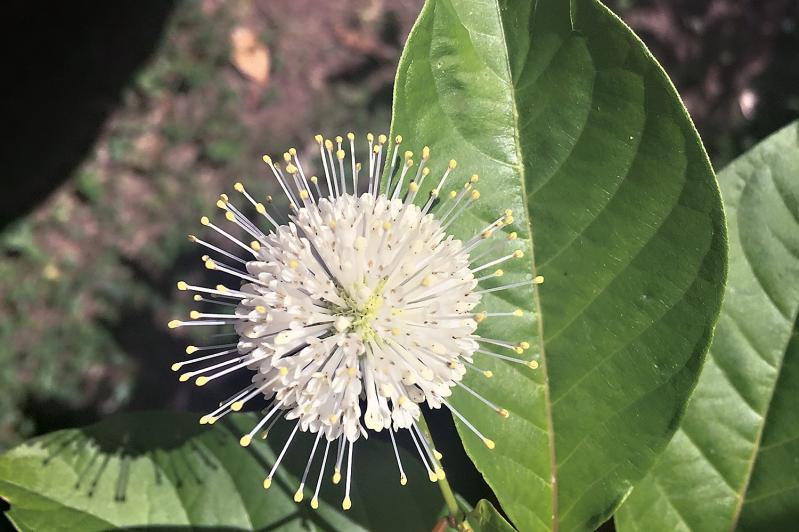Hot, Hot, Hot! Cars, Cars, Cars! Nothing to do but grin and bear it, and observe nature. Both of the fledgling eagles on Accabonac Harbor are now practicing flying, according to Patrice Dalton, who has been keeping a close eye on them, and the baby ospreys are beginning to show up in the air along Long Beach Road in Noyac. Summer always outruns me, more so this year than last. I try to catch up, but I can’t run anymore, can barely walk. If it weren’t for all of the wonderful observers who call or send me notes, I wouldn’t know what was happening out there.
I have yet to see a monarch butterfly for myself. As of Sunday, Vicki Bustamante, who has been keeping track of the monarchs she observes each year, has already counted 23 since seeing her first on June 21. Mathew Galcik, grandson of Walter (the Great) Galcik, has been tending to his Montauk Monarch Ranch for several weeks now. He’s only seen a few adults, but has had several advanced caterpillars that have since pupated out of sight. In a week or so he will find himself surrounded by flashes of orange and black as a new crop of adults leave their pupal stages and show off their new wings. I have some very beautiful orange milkweeds flowering, but nary a monarch, although a black swallowtail visited them a week ago. But I’m not giving up on the monarchs after seeing one last year.
The naturalist Karen Blumer sent me a picture of a buttonbush, Cephalanthus occidentalis, which just burst into flower. She has nurtured it for 20 years, ever since she transplanted a little one, but it only leafed out each year, never bloomed. Months ago, she moved into a new house and took the plant with her. It is no longer barren. I have a buttonbush in a pot in my yard that I have cared for each year for 10 years now; it has yet to bloom, but after Karen’s success, I am feeling more optimistic.
The buttonbush is not that common, but you can see it in bloom at the edges of freshwater ponds and swamps. One of the most glorious assemblages of the species is found on the west side of West Lake Drive in Montauk as it courses past Drumm Pond — named after the late Russell Drumm — just south of Star Island. Most Star readers will remember Russell as a Star regular who covered the local fishing culture among other topics for more than 20 years while also authoring several books on the side. Whenever I pass that pond edge, I think of him and the mature buttonbushes peaking out, but you have to have a sharp eye to see them, as phragmites has pretty much taken over the road shoulder there.
Meanwhile, the South Fork is loaded with those horrible little black mosquitoes from Japan that attack whether it’s light or dark. The way I reduce their presence around my stoop is to stand outside with hardly anything on and slap each one forcefully as it lands on me and begins to stick its proboscis into my flesh. The ones that attach to my backside I flail at with a towel or The New York Times still in its blue wrapper. It makes a wonderful fly swatter.
I have had a hard time sleeping when it’s been so hot in my room, often more than 86 degrees. At times I’m still awake when it starts to get light a little after 5 a.m. Last Thursday morning at about that time I looked out my window and what did I see but a large male white-tailed deer with a marvelous wrack of antlers. He was methodically eating the leaves of a mock orange shrub, at times standing up on his two hind legs with his tail showing only white reaching way up to get the newest leaves. After that, he went to the lower-down catbrier leaves, and from there he began nibbling the black cherries and other shrubs.
As I watched through the window of a still dark room without moving a muscle, a larger stag with an even larger rack walked past the first deer, followed by a third male equally as large as the first one. I was dumbfounded. A few days earlier I had noticed that some of the daylily leaves had been chomped on, possible the work of a deer, yet I had seen no other signs of one since last year. The three slowly walked to the west and out of sight. They were magnificent!
The fireflies are still flashing in the front yard as summer progresses. The hotter it gets, it seems, the more flashes they utter. They also start a minute or so earlier each evening, reminding me that the days are already getting shorter as we approach the end of a month since the summer equinox on June 21. Tuesday night was the full buck moon, and I planned to be looking out my window to see if the fireflies took a break.
Larry Penny can be reached via email at [email protected].

